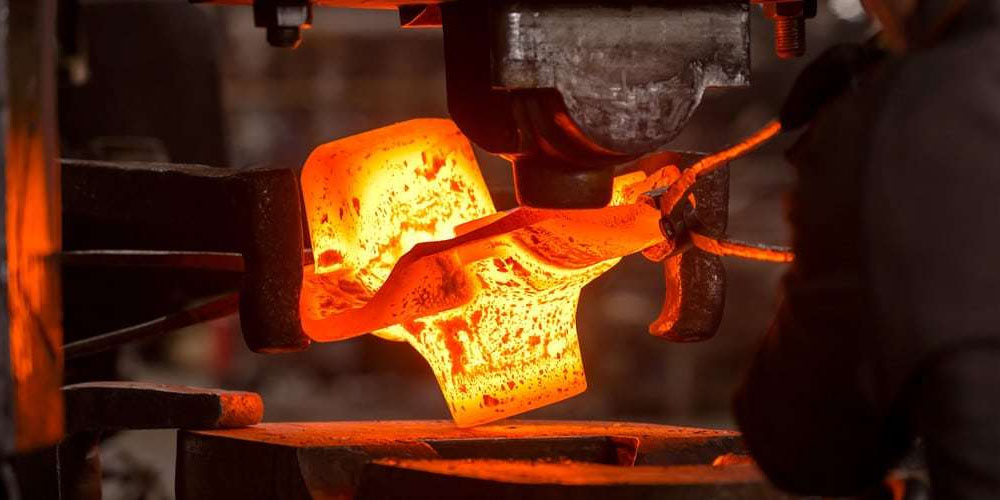2. Aerospace Application
The steel forging process allows the formation of high-strength and temperature-resistant components for the aerospace industry. Additionally, it allows the forging of lightweight construction components and titanium and nickel-based alloys. Some of the forging components are:
- Fuel usage components like window frames, ribs, and window and door fittings
- Rotor systems: Gearbox cover and fittings.
- Landing gear: Pins, carriers, and fasteners
- Engine with turbine blades and control levers
- Fittings for the empennage.
Besides aerospace and automobile applications, the hot forging process also showcases its strengths in other areas, including construction, precision engineering and watchmaking industry, offshore sector, agriculture, and steel production. What’s more, industries like defense, mechanical engineering, and sanitary also require hot forging.
Conclusion
Hot forging is a manufacturing process that produces components with superior mechanical properties making it ideal for the automotive, aerospace, and engineering fields.
Forging can be divided into three categories according to the forging temperature: hot, cold, and warm forging. Hot forging is the most common forging process. The method is used when forging components that are hard to forge by other conventional means. In the hot die forging process, metals are forged above the metal’s recrystallization temperature. The high temperatures at which new grains form in the workpiece are necessary to prevent the metal from strain hardening during its deformation.
Barreling Effect in Hot Forging Process
Friction plays a critical role in actual conditions during the manufacturing process. Friction combats the spread of the material near the surfaces and allows the materials at the center to expand easily. The effect is known as barreling, and it leads to the creation of a barrel shape. Barreling is undesirable, and manufacturers can control it by using sufficient lubrication.
Hot forging also involves heat transfer between the cold die and the hot metal, which increases the barreling effect. The metal next to the die surfaces cools faster than that nearer the center. Compared to the hotter center material, the cooler components will be more resistant to deformation; therefore, they will expand less, resulting in a barreling effect.
Hot Forging Applications
The recrystallization process involves the use of extremely high temperatures. The process enhances formability and enables precise and fine-grained metal microstructure. Hot forging combines higher strengths and durability than other forming processes, making it possible to apply it to manufacturing processes where high operating static and dynamic loads demand unique components. These components are called Safety Critical Parts. For this reason, the automobile and aerospace sectors widely use hot forgings.
1. Hot Forging Application in Automobile Sector
Steel forging is commonly used in the automotive industry. Wrought aluminum alloys are lighter than magnesium hence their increased construction demands. Manufactures in the automotive industry apply a closed die forging process to make small and medium-sized components. The process results in high strength and better functional automotive components. Some of the typical forging products include:
- Brake system: Brake handles and carriers
- Engine parts: Crankshafts, balance shafts, connecting rods, valves, and camshafts
- Powertrain: Wheel hubs, joint discs, flange yokes, and universal joints.
- Undercarriages: Axle stub, steering levers, wishbones, and wheel carriers
- Driving gear: Synchronizer rings and pinions
2. Aerospace Application
The steel forging process allows the formation of high-strength and temperature-resistant components for the aerospace industry. Additionally, it allows the forging of lightweight construction components and titanium and nickel-based alloys. Some of the forging components are:
- Fuel usage components like window frames, ribs, and window and door fittings
- Rotor systems: Gearbox cover and fittings.
- Landing gear: Pins, carriers, and fasteners
- Engine with turbine blades and control levers
- Fittings for the empennage.
Besides aerospace and automobile applications, the hot forging process also showcases its strengths in other areas, including construction, precision engineering and watchmaking industry, offshore sector, agriculture, and steel production. What’s more, industries like defense, mechanical engineering, and sanitary also require hot forging.
Conclusion
Hot forging is a manufacturing process that produces components with superior mechanical properties making it ideal for the automotive, aerospace, and engineering fields.
